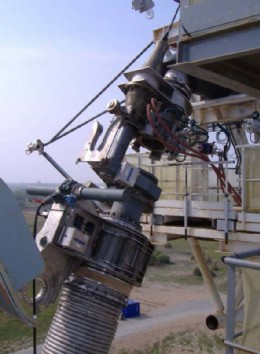Liquefied gas - The challenge for valves

Fig. 1 DANAIS cryogenic butterfly valve undergoing liquid nitrogen testing

Fig. 2 Offshore plants are envisaged on so-called FPSO (Floating Production Storage and Offloading) tankers for natural gas fields that are located far out at sea.

Fig. 3 Connectis is the loading system developed as a joint industrial project (JIP) between Technip, Eurodim and KSB.
To effectively shut off pipes when handling LNG, valves have to be reliable and their design requires them to be capable of coping with the special physical and chemical properties of this medium. Under the AMRI brand, KSB has been producing butterfly valves for the entire LNG process chain for several decades. In co-operation with the companies Technip and Eurodim, KSB has also developed an offshore loading system – Connectis.
The temperature of LNG is extremely low and at these exceptionally cold temperatures most metals become brittle and have little strength. Very few metals fulfil the high standards that guarantee operating reliability, a long service life and functional safety. As every valve undergoes a test with liquid nitrogen, the valves are required to work safely and properly at temperatures as low as -196°C.
Different requirements in the logistics chain
As well as being able to withstand low temperatures, all components involved in the process must also be able to cope with substantial heat expansions. These occur during the transitional phases through the process of being cooled and then warmed up again to ambient temperature. Another factor which places strain on the valves is the operating pressure and the resulting differential pressure. The pressure classes applied in such systems are ANSI Class 150, 300 and 600. The current trend among valves for these applications is even towards compliance with ANSI Class 900 (150 bar) and developments are accordingly already underway. Depending on where they are used, the valves are either flanged or welded into the pipe.
After the natural gas has been purified, it is turned into a liquid state via a complex liquefying train. Currently, these liquefying trains are located on land. However, the construction of offshore plants is envisaged on so-called FPSO (Floating Production Storage and Offloading) tankers for natural gas fields that are located far out at sea (Fig. 2). At the ports, the LNG is loaded onto tankers via flexible loading arms fitted with valves and typically each liquefied gas tanker is equipped with 60 to 80 valves.
On arrival at the terminals, the liquid natural gas is fed into LNG tanks using flexible loading arms. In order to save space, but also for safety reasons and to avoid proximity to cities, plans are underway to construct FSRUs (floating storage re-gasification units) or offshore terminals several kilometres out to sea. The demands placed on valves for these terminals will be the same as those for liquefying trains.
Technical development of double-offset and triple offset valves
The design of cryogenic valves is determined by three factors:
• Low temperatures (materials)
• Operating pressure (body design)
• Differential pressure (tight shut-off)
In the case of liquefied gas and the associated temperatures, tight shut-off can only be ensured by a metal seat. This requires three design features which clearly distinguish these butterfly valves from softseated, centred variants:
1. The stem is offset relative to its passages through the valve body and is equipped with a graphite joint ring and O-rings. In the event of a fire, this solution ensures that the valve provides tight shut-off for a limited amount of time.
2. A further offset refers to the stem which is laterally offset relative to the pipe axis. This reduces the angle at which the disc is in contact with the seat during closing and opening to only 35°. The contact pressure and wear are thus reduced while the service life is prolonged.
3. To achieve shut-off at even higher pressures, triple offset is required. It refers to the disc’s geometry and reduces the angle at which the seal element is in contact with the seat/disc interface to as little 5°. Despite higher pressures, this helps increase the valve’s service life.
Offshore loading using the KSB Connectis system
‘The motion of the tanker at sea requires flexible loading equipment with an extremely safe connection system. Connectis (Fig. 3) is the loading system developed for this purpose as a joint industrial project (JIP) between Technip, Eurodim and KSB. ‘It allows fast connection and removal says,’ Pascal Vinzio, Head of Valve Research and Pre-development KSB AMRI. ‘The Connectis system can be used for conventional onshore installations and can be mounted onto flexible pipes and conventional articulated loading arms.’
KSB has identified other areas where the Connectis system could be used, for example, loading liquid products from one ship to the next at sea, so heavy mechanical loading equipment would no longer be necessary. To enable large volume loading, a dedicated tandem variant of the Connectis system has been developed in cooperation with Technip (and its subsidiary which has many years of experience in the hose sector) for a project for the oil and gas company Petrobas.
KSB
Tel: +44 1509 231872
www.ksb.com
Published: 26th June 2013
Rachel Wormald, Managing Director at YPS Valves Ltd and Elizabeth Waterman, ...
Are you looking for industry-leading, brand independent valve and actuator ...
As can be seen from the photograph, clearly the resident birds at Bartlett ...
Howco Group has unveiled its latest £1million investment, with the ...
In 2024, Allvalves is poised for an exciting year of growth and expansion, ...
GMM Pfaudler Engineered Plastics & Gaskets are delighted to bring the ...
In the ever-evolving valve industry, GMM Pfaudler stands out for its ...
SAMSON Controls Ltd – part of the SAMSON group - a renowned leader in ...










